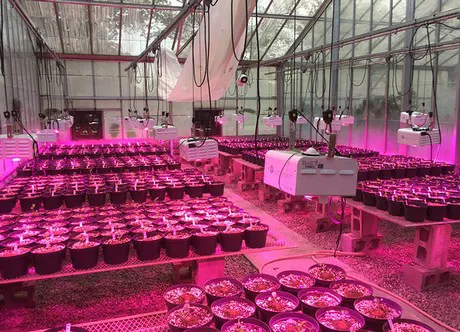Short days during fall and winter are not providing enough light for seed production for brassicas. Therefore Miami University asked LumiGrow to implement their smartPARTM Wireless Control System. The result is that the Brassica plants flowering earlier and successfully producing seeds.

A Year’s Worth of Work Lost
Since Rob Baker, Assistant Professor for the Department of Biology at Miami University in Ohio, needs to work with the cultivars whose genes he has sequenced, he grows all of his own seeds for his research. Rob is growing 700 different genotypes to collect seeds for his experiments next year.
“I came to Ohio from the Intermountain West, which gets 300+ days of sun a year,” says Rob, “Ohio is drastically less sunny. I didn’t have any supplemental light at the greenhouse here, and there just wasn’t enough sunlight for the plants to flower. I lost a year’s worth of work.”
The plants’ dismal seed production prompted Rob to look for grow lights for his brassicas. Rob had worked with LumiGrow fixtures at the University of Wyoming and liked that he could alter the ratio of red to blue light. When he reached out to LumiGrow, they immediately began to put together a custom light plan for Belk Greenhouse.
Switching to Wireless control system
Miami University installed LumiGrow fixtures with LumiGrow smartPARTM Wireless Control System in Belk Greenhouse. Rob began using them to extend his photoperiod to 16 hours. He turns them on from 5 am until sunrise, and then again from 4 pm until 9 pm.
“The brassicas are doing awesome now – the difference is phenomenal,” says Rob, “They’re flowering much earlier than they were last year. The fixtures have made a huge difference.”
Rob has been collecting data on a number of metrics, including germination rate, flowering time, and chlorophyll content.
Brassica rapa is an incredibly diverse species – despite their radically different appearance, field mustard, bok choy and turnips are all Brassica rapa subspecies. The different organs of harvest – leaves, roots, seeds, and oil – are all harvested at different times, which creates a built-in developmental component that allows Rob to address the questions he is interested in answering.
“Brassica is agriculturally important. The canola [field mustard] industry alone brings in several hundred million dollars annually,” says Rob, “Studying how abiotic factors influence the plant at each stage of development has real implications for how people plant, grow and manage these crops. It’s not just a cool thing to think about from a scientific perspective.”
Rob is excited to use his LumiGrow Light Sensors next year to automatically adjust his fixtures to meet a specific daily light integral (DLI) and use his LumiGrow smartPARTM Wireless Control System to set up zones so that he can run multiple experiments at the same time. Thanks to Belk Greenhouse’s LumiGrow fixtures, Rob has everything he needs to start his 2019 research on the right foot.
For more information: LumiGrow
LumiGrow
800-514-0487
info@lumigrow.com
www.lumigrow.com
